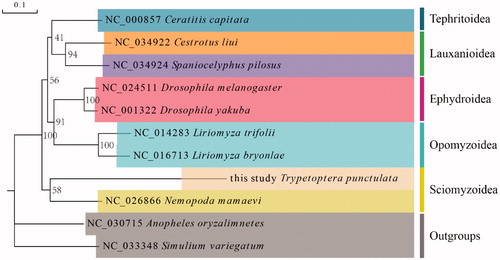Abstract
The mitochondrial genome of Trypetoptera punctulate Scopoli, 1763, the first representative of Sciomyzidae, was sequenced and annotated. And we used this new nucleotide information under Maximum Likelihood analyses to explore the superfamilies relationships of Acalyptratae. The nucleotide composition of Trypetoptera punctulata mitochondrial genome was 34.6% of A, 33.9% of T, 17.6% of C, 13.9% of G, 68.5% of A + T content. The start codon ATG was shared with COX2, COX3, CYTB and ND4; the start codon ATA was shared with ATP6, ND5 and ND6; the ATP8 and ND1 started with codon ATT; the COX1 and ND3 started with codon ATC, and the ND2 and ND6 started with codon TTG. The conservative stop codon TAA was shared with ATP6, ATP8, COX1, COX3, ND1, ND2, ND4, ND4L, ND5 and ND6; and the stop codon TAG was shared with CYTB and ND3.
Acalyptratae contains 69 families in Diptera, this large group is divided into 9 superfamilies (Pape et al. Citation2011). Based on Hennig’s (Citation1958, Citation1971, Citation1973) classification, McAlpine (Citation1989) proposed his classification system about superfamilies within Acalyptratae, and several superfamilies were recovered with minor modifications by Wiegmann et al. (Citation2011). Although the phylogenetic relationships of Acalyptratae have been debated for a long time, Dipterists faced challenges in defining the superfamilies’ monophyly in Acalyptratae. Due to the parallelisms, convergences and morphological features are similar between families, the phylogeny of superfamilies needs more information to be constructed (McAlpine Citation1989). Nevertheless, till now, because of limitation and conflicts of anatomical and genetic evidence, the relationships among groups are obscured and difficult to be resolved (Woodley et al. Citation2009; Sinclair et al. Citation2013). Here, we sequenced mitochondrial genome of T. punctulata Scopoli, 1763, the first representative of Sciomyzidae for further research.
Specimens of T. punctulata were collected in Kanas, Bu’erjin, Xinjiang, China by Bing Zhang, and identified by Zhu Li. Specimens are deposited in the Entomological Museum of China Agricultural University (CAU), Beijing.
The genomic DNA was extracted from adult’s muscle tissues of the thorax using the DNeasy DNA Extraction kit (TIANGEN) and sequenced under the next generation sequence technology. The mitochondrial genome of T. punctulata contains 22 transfer RNA genes, 13 protein-coding genes, 2 ribosomal RNA genes and non-coding control regions, which were similar with related reports before (Li et al. Citation2017a; Wang et al. Citation2017; Zhou et al. Citation2017; Li et al. Citation2017b). The nucleotide composition of T. punctulata mitochondrial genome was 34.6% of A, 33.9% of T, 17.6% of C, 13.9% of G, 68.5% of A + T content. The start codon ATG was shared with COX2, COX3, CYTB, ND4; the start codon ATA was shared with ATP6, ND5 and ND6; the ATP8 and ND1 started with codon ATT; the COX1 and ND3 started with codon ATC, and the ND2 and ND6 started with codon TTG. The conservative stop codon TAA was shared with ATP6, ATP8, COX1, COX3, ND1, ND2, ND4, ND4L, ND5, and ND6; and the stop codon TAG was shared with CYTB and ND3. All 13 protein-coding genes (PCGs) and 2 Ribosomal RNA among 11 species were used to conduct a phylogenetic analysis with the Maximum Likelihood method (ML) at online version RAxML (Stamatakis et al. Citation2008). The ML tree topology was given as . In ML analyses, the outgroups Anopheles oryzalimnetes and Simulium variegatum form a clade diverged from Acalyptratae clades. The Sciomyzoidea consisted of Sciomyzidae and Sepsidae is monophyletic at the base of Acalyptratae and sister group to ([Opomyzoidea + Ephydroidea] + [(Lauxanioidea + Tephritoidea]).
Disclosure statement
No potential conflict of interest was reported by the authors.
Additional information
Funding
References
- Hennig W. 1958. Die Familien der Diptera Schizophora und ihre phylogenetischen Verwadndtschafts-beziehungen [The families of the Diptera Schizophora and their phylogenetic relationship] Beiträge Zur Entomologie [Contributions to Entomology] 8:505–688.
- Hennig W. 1971. Neue Untersuchungen über die Familien der Diptera Schizophora (Diptera: Cyclorrhapha.) [New studies on the families of the Diptera Schizophora (Diptera: Cyclorrhapha.)] Stuuttgarter Beiträge Zur Naturkunde [Stuuttgarter Contributions to Natural science] 226:1–76.
- Hennig W. 1973. Diptera (Zweiflügler). In: Helmcke J G, Stark D, Wermuth H, editors. Handbuch der Zoologie, Vol. 4: Arthropoda–2. Hälfte: Insecta, 2. Teil: Spezielles. 2nd ed. Berlin: Walter de Gruyter. 1–337.
- Li X, Ding S, Hou P, Liu X, Zhang C, Yang D. 2017a. Mitochondrial genome analysis of Ectophasia rotundiventris (Diptera: Tachinidae). Mitochondrial DNA B. 2:457–458.
- Li X, Ding S, Li X, Hou P, Tang C, Yang D. 2017b. The complete mitochondrial genome analysis of Eristalis tenax (Diptera, Syrphidae). Mitochondrial DNA Part B. 2:654–655.
- McAlpine JF. 1989. Phylogeny and classification of the Muscomorpha. In: McAlpine JF, Wood DM, editors. Manual of Nearctic Diptera. Vol. 3. Chapter 116. Agriculture Canada Monograph: Quebec, Canada; p. 1397–1518.
- Pape T, Blagoderov V, Mostovski MB. 2011. Order Diptera Linnaeus, 1758. Zootaxa. 3148:222–229.
- Sinclair BJ, Brooks SE, Cumming JM. 2013. Male terminalia of Diptera (Insecta): a review of evolutionary trends, homology and phylogenetic implications. Insect Sys Evol. 44:373–415.
- Stamatakis A, Hoover P, Rougemont J. 2008. A rapid bootstrap algorithm for the RAxML web-servers. Syst Biol. 57:758–771.
- Wang L, Yang D, Ding S, Li X, Zhang J, Tao M. 2017. Complete mitochondrial genome of Hydrellia griseola (Diptera, Ephydridae). Mitochondrial DNA Part B. 2:591–592.
- Wiegmann BM, Trautwein MD, Winkler IS, Barr NB, Kim J-W, Lambkin C, Bertone MA, Cassel BK, Bayless KM, Heimberg AM, et al. 2011. Episodic radiations in the fly tree of life. Proceed Nat Acad Sci USA. 108:5690–5695.
- Woodley NE, Borkent A, Wheeler TA. 2009. Phylogeney of the Diptera. In: Brown B V, Borkent A, Cumming J M, Wood D M, Zumbado M, editors. 2009 Manual of Central American Diptera. Vol 1. Ottawa, ON: NRC Research Press. p. 79–94.
- Zhou Q, Ding S, Li X, Zhang T, Yang D. 2017. Complete mitochondrial genome of Allognosta vagans (Diptera, Stratiomyidae). Mitochondrial DNA Part B. 2:461–462.

